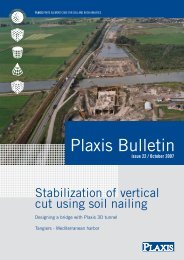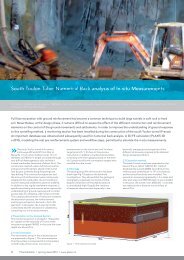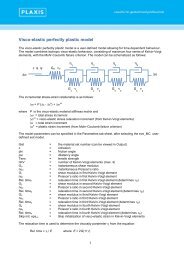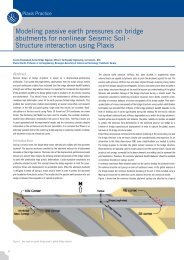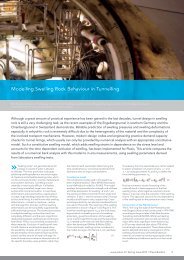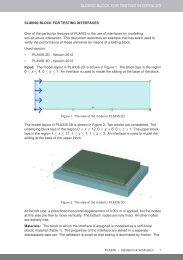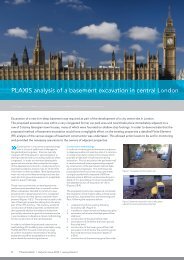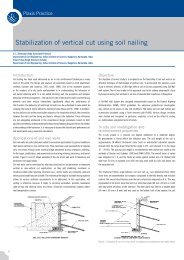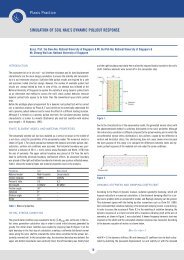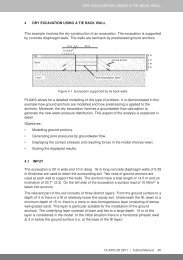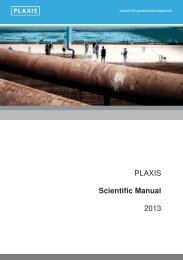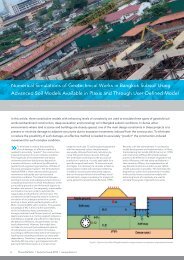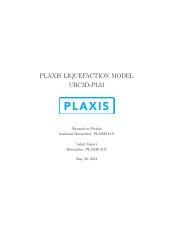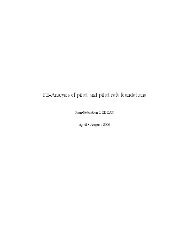Iss31 Art3 - Numerical Analysis of Piled Embankments ... - Plaxis
Iss31 Art3 - Numerical Analysis of Piled Embankments ... - Plaxis
Iss31 Art3 - Numerical Analysis of Piled Embankments ... - Plaxis
You also want an ePaper? Increase the reach of your titles
YUMPU automatically turns print PDFs into web optimized ePapers that Google loves.
<strong>Numerical</strong> analysis <strong>of</strong> geosynthetic reinforced piled embankment scale model tests<br />
Displacements have been measured at three<br />
places: in the middle <strong>of</strong> four piles (z1), in the<br />
middle <strong>of</strong> two piles (z2) and close to a pile (z3).<br />
Displacements z1 and z3 are shown in figure 9.<br />
Displacement z2 is not shown, because this<br />
displacement does not differ from displacement<br />
z3. The displacement is presented as a function <strong>of</strong><br />
the net load. From the comparison <strong>of</strong> results<br />
between <strong>Plaxis</strong> and the measurements it can be<br />
concluded that the displacement is<br />
underestimated significantly by <strong>Plaxis</strong>. Farag<br />
(2008) also found much lower settlements in his<br />
<strong>Plaxis</strong> calculations. In CUR 226 (2010) this is solved<br />
by modelling a gap underneath the GR in the<br />
<strong>Plaxis</strong> calculations.<br />
Several possible causes <strong>of</strong> the underestimated<br />
displacements have been investigated: among<br />
them the behaviour <strong>of</strong> the subsoil, <strong>of</strong> the GR and<br />
<strong>of</strong> the granular material. Each individual aspect<br />
gives a very limited improvement conform the<br />
measured displacements. Therefore, the cause <strong>of</strong><br />
the underestimated displacements should be<br />
investigated in more detail.<br />
References<br />
• CUR 226, 2010, Ontwerprichtlijn paalmatrassystemen<br />
ISBN 978-90-376-0518-1 (in Dutch)<br />
• Den Boogert, T.J.M., 2011. <strong>Piled</strong> embankments<br />
with geosynthetic reinforcement, <strong>Numerical</strong><br />
analysis <strong>of</strong> scale model tests, Master <strong>of</strong> Science<br />
thesis, Delft University <strong>of</strong> Technology.<br />
• Van Eekelen, S.J.M., Bezuijen, A., Lodder, H.-J.<br />
& Van Tol, A.F., 2011a. Model experiments<br />
on piled embankments Part I, Geotextiles<br />
and Geomembranes, 2011, http://dx.doi.<br />
org/10.1016/j.geotexmem.2011.11.002<br />
• Van Eekelen, S.J.M., Lodder, H.J., Bezuijen, A.,<br />
2011b, Paalmatrasproeven I, Vervormingen van<br />
geokunstst<strong>of</strong>fen in een paalmatras en de daaruit<br />
volgende belastingsverdeling, GeoKunst<br />
42, april 2011, 42-44<br />
• Van Eekelen, S.J.M., Van der Vegt, J.W.G.,<br />
Lodder, H.J., Bezuijen, A., 2011c, Paalmatrasproeven<br />
II, belangrijkste conclusies, GeoKunst 43,<br />
juli 2011, pp 46-50<br />
Conclusions and recommendations<br />
From the FEM model is concluded that arching<br />
occurs in the granular material. The effective<br />
vertical stresses are concentrated on top and the<br />
area next to the piles. The tensile forces in the GR<br />
are concentrated in ‘tensile strips’ between the<br />
piles. The exact location <strong>of</strong> the greatest tensile<br />
forces could not be determined because <strong>of</strong> the<br />
coarseness <strong>of</strong> the mesh.<br />
In accordance with the measurements, <strong>Plaxis</strong><br />
calculations give a smooth relationship between<br />
the net load and load parts A and B, and the<br />
GR settlements. During the first part <strong>of</strong> the test,<br />
the load distribution <strong>of</strong> the model agrees quite<br />
well with the measured load distribution. During<br />
the second part <strong>of</strong> the test, the load transferred<br />
through arching is overestimated and the load<br />
transferred through the GR is underestimated.<br />
In general, <strong>Plaxis</strong> finds an increasing arch<br />
during drainage <strong>of</strong> the subsoil (consolidation),<br />
this is in agreement with the measurements.<br />
The displacements calculated with <strong>Plaxis</strong> are<br />
underestimated compared to the scale test<br />
results. However, the largest displacement <strong>of</strong> the<br />
GR is found at the middle <strong>of</strong> four piles.<br />
To increase the accuracy <strong>of</strong> the <strong>Plaxis</strong> results, the<br />
model should be calculated with a more refined<br />
mesh. The loss <strong>of</strong> load (due to friction) during the<br />
scale test is an important part <strong>of</strong> the scale test.<br />
It produces disturbance in the load distribution<br />
<strong>of</strong> the granular material. The friction should be<br />
included in the <strong>Plaxis</strong> model by an interface,<br />
therefore it is advised to perform numerical<br />
analysis <strong>of</strong> the scale model test with the full 3D<br />
version <strong>of</strong> <strong>Plaxis</strong>. The cause <strong>of</strong> the differences in<br />
calculated and measured displacement <strong>of</strong> the GR<br />
has to be investigated in more detail.<br />
www.plaxis.nl l Spring issue 2012 l <strong>Plaxis</strong> Bulletin 17



